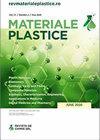Mechanical Character Analysis of Pineapple Fibre Epoxy Composite with Nanoclay Quantity Variation
IF 0.6
4区 材料科学
Q4 MATERIALS SCIENCE, MULTIDISCIPLINARY
引用次数: 0
Abstract
Epoxy based hybrid composites are extremely wide used materials in the polymer engineering field and always have a demand for their versatile applications. Nano clay is yet another trending substance handled by many researchers due to their enhanced abrasion characteristics. This research was performed to investigate the effect of dispersing nanoclay into epoxy matrix and further coupled with pineapple fibers to fabricate a hybrid composite of excellent mechanical property. 4 layers of Pineapple fiber mats were compression moulded with epoxy nanoclay blend to obtain composite specimens of 4mm thickness. Nanoclay was added into epoxy resin at four different weight ratios (2%, 4%, 6%, and 8%) to form four different combinations of matrix materials into which pineapple fiber mats were reinforced individually at a constant weight ratio of 25%. The enhancement of mechanical and abrasion rate of the hybrid composites were matched with those of the neat Epoxy/Pineapple fiber composites that are currently being developed as alternatives for brake pads. Moisture absorption rate of the composites were analysed to ASTM D570 and Morphology was inspected using Field Emission Scanning Electron Microscope (FESEM). The results depicted optimum mechanical performance at 4 wt% nanoclay infused epoxy/pineapple fiber composite that had a tensile strength of 166.75 MPa, flexural strength of 801.15 MPa and impact strength of 148.76 kg/sq. m. The least abrasion rate was detected in the composite with 8 wt% nanoclay content, resulting in an abrasion rate of 0.1064 g/m.纳米粘土用量变化下菠萝纤维-环氧树脂复合材料力学性能分析
环氧基杂化复合材料是聚合物工程领域中应用极为广泛的材料,对其多功能应用一直有需求。纳米粘土由于其增强的磨损特性,是许多研究人员处理的另一种趋势物质。本研究旨在研究将纳米粘土分散到环氧树脂基体中,并与菠萝纤维进一步偶联,制备出力学性能优异的杂化复合材料的效果。用环氧纳米粘土混合物对4层菠萝纤维垫进行模压,以获得4mm厚度的复合试样。将纳米粘土以四种不同的重量比(2%、4%、6%和8%)添加到环氧树脂中,以形成四种不同基质材料组合,其中菠萝纤维垫以25%的恒定重量比单独增强。混合复合材料的机械性能和耐磨性的提高与目前正在开发的纯环氧树脂/菠萝纤维复合材料相匹配,后者是刹车片的替代品。根据ASTM D570分析复合材料的吸湿率,并使用场发射扫描电子显微镜(FESEM)检查形态。结果表明,在4wt%纳米粘土注入的环氧树脂/菠萝纤维复合材料下,其最佳机械性能为166.75MPa的拉伸强度、801.15MPa的弯曲强度和148.76kg/sq.的冲击强度。m.在具有8wt%纳米粘土含量的复合材料中检测到最小的磨损率,导致0.1064g/m的磨损率。
本文章由计算机程序翻译,如有差异,请以英文原文为准。
求助全文
约1分钟内获得全文
求助全文
来源期刊

Materiale Plastice
MATERIALS SCIENCE, MULTIDISCIPLINARY-
CiteScore
1.40
自引率
25.00%
发文量
99
审稿时长
6-12 weeks
期刊介绍:
Materiale Plastice, abbreviated as Mater. Plast., publishes original scientific papers or guest reviews on topics of great interest.
The Journal does not publish memos, technical reports or non-original papers (that are a compiling of literature data) or papers that have been already published in other national or foreign Journal.
 求助内容:
求助内容: 应助结果提醒方式:
应助结果提醒方式:


